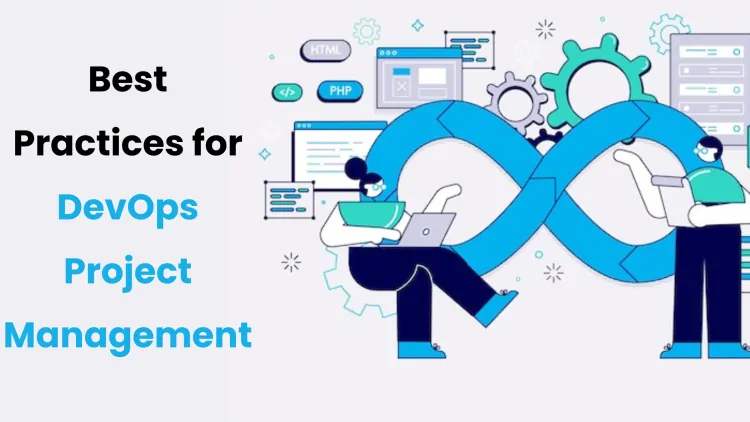Best Practices for DevOps Project Management
DevOps bridges development and operations, improving software delivery speed, business strategy, and market competitiveness.

DevOps project management is revolutionizing businesses by enhancing the collaboration between the two most crucial teams in an organization—Development (Dev) and Operations (Ops) teams. By breaking down the silos and unlocking cross-functional teamwork, DevOps project management streamlines the comprehensive processes and delivers faster services.
However, easier said than done, introducing DevOps project management is a multifaceted challenge. From implementing DevOps best practices to staying updated, this extensive procedure needs supervision and constant reminders about staying on the right track.
This blog navigates through DevOps project management and explores its components, principles, and other crucial aspects.
Let’s dive.

Why DevOps Project Management Matters?
In today’s fast-paced competition, staying accurate about the improvements and saving time are extremely important. That’s why DevOps services are on the rise.
DevOps project management offers a variety of benefits—from faster time to market and increased efficiency to high scalability and rapid performance optimization. Additionally, increased customer-centric products and more automation equip a business with skills to strive better in the dynamic market.
Before we further delve into what exactly is DevOps project management, let’s understand what are development and operations teams.
What Is a Development Team?
A development team in an organization is responsible for designing, developing, and testing software products. A development team comprises developers/software engineers, project managers, quality analysts, product owners, business analysts, UI/UX designers, DevOps engineers, database administrators, and system architects. This team collectively accounts for software's intended functioning, updates codes, implements feedback, and ensures the product meets users’ expectations and business goals.
What Is an Operations Team?
An operation team ensures different systems, software, and devices work efficiently and exchange information and data for a seamless IT environment. The team consists of system, database, and network administrators, security analysts, support, backup, and recovery specialists, DevOps engineers, and IT service managers, who collaborate and ensure business continuity by minimizing downtimes and increasing operational efficiency to achieve business goals.
The benefits of DevOps project management are listed below.
Let’s quickly delve.
Components of DevOps Project Management
Let’s understand what DevOps project management comprises and the essential requirements for establishing a full-fledged DevOps environment in an IT company.
Let’s start.
Continuous Integration and Continuous Deployment (CI/CD)
Continuous Integration (CI) allows developers to frequently integrate code changes into a shared repository where automated builds and tests detect issues in early phases.
Continuous Deployment (CD) enables easy deployment of code changes to the production environments automatically after they successfully pass automated tests, ensuring rapid and reliable releases.
Infrastructure as Code (IaC)
Infrastructure as a Code includes managing and provisioning computing infrastructure through machine-readable configuration files rather than physical hardware or interactive configuration tools. IaC leads to consistent infrastructure setups throughout the management process, high scalability, increased collaboration, optimized costs, and increased reliability.
Automation
Automation enables automating and streamlining repetitive tasks such as testing, deployment, monitoring, and infrastructure management to reduce human error and increase efficiency. Additionally, automation saves costs and resources by queuing tasks without manual operations.
Collaboration and Communication
Promoting a culture of collaboration and shared responsibility between development, operations, and other stakeholders. Using collaboration tools like Slack, Microsoft Teams, and Confluence to facilitate communication.
Monitoring and Logging
Implementing continuous monitoring and logging to track application performance, detect issues, and analyze system behavior. Tools like Prometheus, Grafana, ELK Stack (Elasticsearch, Logstash, Kibana), and Splunk are used for monitoring and logging.
Agile Practices
Integrating Agile methodologies such as Scrum or Kanban to manage project tasks, sprints, and iterative development. Using project management tools like Jira, Trello, or Azure DevOps boards to track progress and manage backlogs.

Principles of DevOps Project Management
Under every DevOps project management lies a set of principles that drive the process and define its purpose. These principles define the strategy for a DevOps company to follow the best practices adequately and target the core aspects of DevOps before anything else.
Collaboration and Transparency
Fostering open communication and collaboration between all team members ensures everyone is aligned and working towards common goals. Maintain transparency in processes, progress, and issues to facilitate trust and accountability.
Customer-Centric Approach
Deliver value to customers by continuously improving the product based on feedback and requirements. Prioritize features and fixes that have the highest impact on customer satisfaction and business objectives.
Automation and Efficiency
Automate as many processes as possible to improve efficiency and reduce the potential for human error. Continuously seek ways to streamline workflows and eliminate bottlenecks to enhance operational efficiency while delivering and improving products.
Continuous Improvement
Prioritize continuous improvement by regularly evaluating processes, tools, and practices. Conduct retrospectives to identify areas for improvement and implement actionable changes.
Flexibility and Adaptability
Implement flexibility and adaptability to changing requirements and circumstances. Enforce iterative development and incremental delivery to respond quickly to changes and deliver value continuously.
Measurement and Optimization
Measure key performance indicators (KPIs) and metrics to assess the effectiveness of processes and identify areas for optimization. Use data-driven insights to make informed decisions and drive improvements.
Tools for Effective DevOps Project Management
- CI/CD Tools—Jenkins, GitLab CI/CD, CircleCI, Travis CI
- Configuration Management Tools— Ansible, Puppet, Chef
- Infrastructure as Code Tools— Terraform, CloudFormation
- Containerization and Orchestration Tools—Docker, Kubernetes
- Monitoring and Logging Tools—Prometheus, Grafana, ELK Stack, Splunk
- Collaboration Tools—Slack, Microsoft Teams, Confluence
- Project Management Tools— Jira, Trello, Azure DevOps Boards
By integrating these components and principles, DevOps project management enhances the speed, quality, and reliability of product delivery, leading to client satisfaction and steady growth.
Conclusion
DevOps project management can transform the complete business operations by bridging gaps between the development and operations teams. As contemporary times demand rapid software development and, more than that, faster updates, DevOps is an unfailing strategy to improve software and meet user needs specifically. Additionally, for businesses, DevOps is nothing short of an important business strategy to lead the market and deliver products timely.
What's Your Reaction?
















